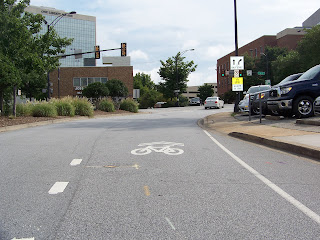On my way home the other night, I was thinking about the transportation mode shift that's been happening across the country for several years and how that's affecting young people: people are driving few miles every year. There was a study done by the US Pirg's and others that shows some pretty interesting trends. Translate that study into policy and infrastructure needs, and the take away result is we don't need more miles of new roadway. Let's take a closer look.
1. Decrease in vehicle miles traveled by the average US citizen. Why is this important? From World War II up until just after 2000, the rate of vehicle miles traveled was on a pretty steady upward trend. In 2004, that rate dropped - and that was before the economy tanked in 2008. In 2011, the average US citizen drove 6% fewer miles than in 2004. That's an increasingly downward trend.
2. Decrease in vehicle miles traveled by young adults. What does this mean? Young adults are the age group of 16 - 34 year olds. This means the youngest generation that can drive is driving less - and the study shows that they are riding public transportation, bicycles and walking more.
3. Fewer young adults are getting their license. Why does this matter? Those who are 14 - 34 years old are choosing to forfeit the right to drive. From 2000 - 2010, the rate of those who did not have their license went up from 21% to 26%. The study cites all kind of reasons for this change - technology making alternative transportation choices and modes more convenient, increase in fuel prices and changes in driver licensing laws. Graduated licenses, more restrictions behind the wheel and the cost of private classes and tests are all barriers that have contributed to this trend.
These, along with other factors cited in the report paint an interesting picture of our national transportation trends. Especially for young adults - teens, college students and young professionals are all more likely to chose an alternative way to move around than their parents. Cars are less appealing to younger people. I'm sure that getting carted around at a young age in an SUV from school to soccer practice to play dates to piano lessons for many in this generation influenced this trend. Not to mention the increasing cost of living - and the rise in higher education cost and debt. It seems like people today are looking at unconventional ways to stretch a dollar or save a penny. Not buying a car (or having to pay for gas or car insurance) is a huge investment towards the "dollar saved is a dollar earned" mentality.
Using a bicycle to get around is fast, inexpensive and healthy - and addresses some of the concerns listed above. With increased public awareness and concern about the obesity epidemic, climate change and college debt, young adults today are responding to the outcry by changing their behavior in a pretty radical way. They are taking to their bikes in a way that future generations have not. It's a pretty cool and noteworthy trend.
1. Decrease in vehicle miles traveled by the average US citizen. Why is this important? From World War II up until just after 2000, the rate of vehicle miles traveled was on a pretty steady upward trend. In 2004, that rate dropped - and that was before the economy tanked in 2008. In 2011, the average US citizen drove 6% fewer miles than in 2004. That's an increasingly downward trend.
2. Decrease in vehicle miles traveled by young adults. What does this mean? Young adults are the age group of 16 - 34 year olds. This means the youngest generation that can drive is driving less - and the study shows that they are riding public transportation, bicycles and walking more.
3. Fewer young adults are getting their license. Why does this matter? Those who are 14 - 34 years old are choosing to forfeit the right to drive. From 2000 - 2010, the rate of those who did not have their license went up from 21% to 26%. The study cites all kind of reasons for this change - technology making alternative transportation choices and modes more convenient, increase in fuel prices and changes in driver licensing laws. Graduated licenses, more restrictions behind the wheel and the cost of private classes and tests are all barriers that have contributed to this trend.
These, along with other factors cited in the report paint an interesting picture of our national transportation trends. Especially for young adults - teens, college students and young professionals are all more likely to chose an alternative way to move around than their parents. Cars are less appealing to younger people. I'm sure that getting carted around at a young age in an SUV from school to soccer practice to play dates to piano lessons for many in this generation influenced this trend. Not to mention the increasing cost of living - and the rise in higher education cost and debt. It seems like people today are looking at unconventional ways to stretch a dollar or save a penny. Not buying a car (or having to pay for gas or car insurance) is a huge investment towards the "dollar saved is a dollar earned" mentality.
Using a bicycle to get around is fast, inexpensive and healthy - and addresses some of the concerns listed above. With increased public awareness and concern about the obesity epidemic, climate change and college debt, young adults today are responding to the outcry by changing their behavior in a pretty radical way. They are taking to their bikes in a way that future generations have not. It's a pretty cool and noteworthy trend.



